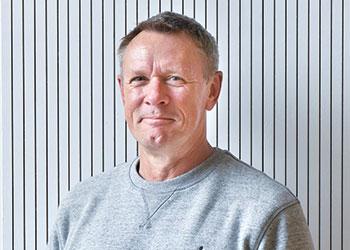
 Einchcomb ... solving fracking challenges using technology
Einchcomb ... solving fracking challenges using technology
STRYDE’s nodes and data processing solutions enable operators to deliver quality seismic data required for intelligent and safe fracking operations, Chris Einchcomb, Geophysical Advisor at STRYDE, tells OGN
As the global demand for energy grows, fracking is once again having its time in the spotlight. This well-stimulation technique is being considered and undertaken by operators in the Middle East, particularly in Saudi Arabia and Oman, to ramp up the production and the supply of unconventional shale residing in tight, low permeability reservoirs.
While tight reservoirs and shale geology in the Middle East are highly promising, the region faces challenges when it comes to fracking, ranging from an acute shortage of fresh water to the increased risk of migration of gases and chemicals to the surface.
Fluid-induced seismicity events associated with shale stimulation is another major obstacle in the Middle East traversed by active faults of various sizes.
In addition, the process of fracking is expensive and less reliable than other methods, and despite the ample information available about these reservoirs — enabled through decades of drilling and production — safe and effective exploration and production optimisation from shale formations and tight reservoirs through fracking will require new data on reservoir characteristics.
Another challenge is the availability of specialist fracking equipment and the logistics of managing multiple jobs. Therefore, it is essential that operators optimise and target the most promising areas and optimise the efficiency of operations.
The acquisition of high-density, high-resolution, and often wide azimuth seismic data is considered a key tool in:
Exploration: Pinpointing optimal and suitable locations for fracking by understanding whether the production of hydrocarbons can be increased, whether its recovery ratio can be improved, or if its reserves can be effectively produced.
Monitoring: Monitoring fracture activity and flow mobilities in hydrocarbon-producing reservoirs to inform reservoir management decisions and further optimise future activity and frack designs.
INTELLIGENT DECISION MAKING
 |
The STRYDE Compact Node Management System |
Some of the key geological issues associated with fracking include:
Limited understanding and lack of control of rock fracture patterns and processes in shales (and tight conventional reservoirs), resulting in reduced confidence about whether hydrocarbons will be able to flow through rock as anticipated and an increased risk profile.
The ability to predict and quantify permeable fracture networks in the subsurface before drilling, especially for long, horizontal wells.
Determination of the accuracy and precision with the geometry of formations and aquifers in the subsurface.
With increased environmental, financial, and geological risks related to fracking, understanding, and controlling high volumes of pressure in the subsurface incurred during fracking activity is crucial.
It is, therefore, more important than ever to utilise seismic data as part of the exploration or production of tight formations to optimisation workflow to de-risk decisions, drill with confidence and ensure a better return on investment.
Seismic data can be used to de-risk operations during three phases of fracking:
1. Frack and well optimisation: Conducting a conventional, wide azimuth 3D seismic survey before the frack to obtain a baseline image of the reservoir, utilising seismic inversion techniques to visualise rock properties. Using specialist processing algorithms on wide azimuth seismic to visualise the fracture distribution will combine to help:
Production engineers to optimise well locations and determine if the fracking results will deliver the desired production results before opening the well.
Drilling and reservoir engineers optimise well and fracking design.
2. Frack monitoring: Micro-seismic monitoring is a valuable tool for understanding what a hydraulic fracture is doing, providing the real-time heights, lengths, orientations, geometries, and spatial arrangements of fractures produced during and after the fracturing operation. This involves seismic sensors being deployed around the well to monitor micro-seismicity to help:
 |
The STRYDE Node |
Reservoir and production engineers monitor the effectiveness of frack treatments and optimise future well placements and designs.
Monitor the subsurface conditions to identify fractures that have the potential to trigger any environmental, seismicity, or safety events.
3. Reservoir monitoring: Conducting 4D seismic surveys after fracking to determine the effectiveness of the treatments and their impact on the subsurface and reservoir. Once again utilising seismic inversion and processing techniques to identify the change in rock properties will help engineers further enhance future well designs and placement and optimise production efficiently.
Until recently, the acquisition of seismic data on land has been an expensive and complex operation, especially in areas like the Middle East where cabled geophones have dominated the exploration and production market.
The complexity of cabled receiver systems makes them heavy, bulky, and expensive to use, limiting the density and azimuth of the receiver sampling and ultimately the seismic image.
The use of this technology also often incurs additional capex and opex costs, HSE risks, and inefficiencies for land seismic, especially in difficult Middle East desert environments where existing oil and gas infrastructure already exists.
Challenging desert environments can often make coupling of conventional geophones more difficult and common sandstorms can also create noisy data that complicates signals and prevents quality subsurface data from being retrieved.
A NEW, LOW-COST SEISMIC SOLUTION FOR INTELLIGENT FRACKING
In 2019, STRYDE launched the world’s smallest, lightest, and most affordable land seismic sensor, following an R&D collaboration project with bp, Rosneft, and WesternGeco.
Coupled with its fast-track data processing algorithms, STRYDE systems enable operators to acquire high-density, high-resolution subsurface images at a significantly reduced price point and achieve seismic images faster than ever before.
STRYDE’s miniature wireless sensors have replaced traditional cable equipment for many leading oil and gas operators across the globe.
Good coupling is enabled by being able to easily bury the node beneath the sand and other terrains, allowing the node to continuously record data in a quiet environment, thus resulting in less noise and better-quality seismic data.
Nodes allow operators to place sensors in any location in flexible geometries over wide distances, both inline and crossline.
Distinct from cable systems, which often require regular, connected geometries, and restricted to specified patches, nodes minimise the need for line clearing and land disruption, as they can be deployed by foot and laid out, independently of each other.
Once left in the ground, the node can be left to its own devices, continuously recording for up to 28 days (or longer in calendar modes), allowing multiple receiver lines and azimuths to be generated from a single shot point, resulting in the acquisition of high-density, long offset and wide azimuth data, which provides high-resolution subsurface insights required to make informed fracking decisions for well optimisation and reservoir management.
This opens a world of opportunity for these critical resources, allowing operators to pinpoint previously untapped geology because exploration areas were deemed impractical or too expensive to analyse.
LEADING THE WAY IN DE-RISKING FRACKING
Clearly understanding the reservoir’s characteristics and production capability makes a significant difference between a cost-effective and successful hydrocarbon extraction, and one that leads to poor production and completion headaches and ultimately wasted spend.
Operators should, therefore, be taking advantage of state-of-the-art technology like STRYDE Nodes™ in order to maximise unconventional or tight hydrocarbon production through fracking.
Put simply, STRYDE’s leading nodal technology and data processing solutions save operators time and money while enabling them to deliver the best quality seismic data required for intelligent and safe fracking operations.


















































































